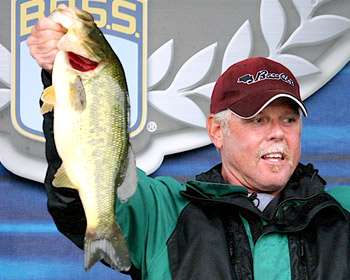
In bass fishing, just like in poker, you have to be able to understand a good bluff. In both cases, the critical factors lie beneath the surface, invisible to the naked eye. If you play your cards wrong, you'll lose, but if you figure out the true nature of the bluff you can walk away with all the chips.
Elite Series pro Mark Tucker of Missouri with bluffs — these vertical banks are his go-to areas in early spring for big largemouth, smallmouth and spotted bass. He knows that bass visit these areas before moving up to spawn, and he's developed a fairly simple system for figuring out which bluff banks are productive and which ones should be avoided.
"The main thing to figure out, considering the time of year and the water temperature, is whether they're in the creeks or still out on the main lake," Tucker says. "If the water is less than 46 or 47 degrees, I try to fish the main lake first, preferably along channel swings. I look for any irregularities in a bluff." If the water is above that 47 degree mark, he'll start in a major creek arm.
"I want to find one with relatively deep water," he explains, "I try to start out in the front and then work about halfway back into the creek." If one side of the creek gets more sunlight, he'll start there. He also looks for places where the bluff has chunk rock mixed in or nearby. The chunk rock attracts crawfish, and fish will feed there in warm periods.
The adjacent bluffs offer vertical cover, enabling bass to go deeper at night as the water cools down. Once he identifies a likely bluff, Tucker says it's critical to cover a lot of water. "Some bluffs can be a mile long," he says. "You have to find every little isolated irregularity, whether it is a cut, a crack or a little dimple in the structure." One might assume that the need to cover water fast necessitates a fast moving lure, and that can be an advantage at times.
Tucker uses a suspending jerkbait or a spinnerbait on occasion. But his number one tool for this purpose is a Picasso or Tru-Tungsten spider jig. On shallower bluffs or when the wind is comparatively light, he'll start with a 1/4-ounce model on 10-pound-test Berkley 100 Fluorocarbon. In deep water, or when there's a breeze, he'll switch to a slightly heaver, 5/16-ounce model on 12-pound fluorocarbon. He doesn't favor long casts, nor does he try to parallel the bluff. "I keep the boat maybe 10 feet away from the bluff," he says.
"I try not to pitch too far out in front because that would cause my bait to hang up more often. I pitch straight out, or maybe a little bit out in front. I try to pitch it as close to the bluff as I can, and leave the reel in freespool. Then I pull line out as it falls," to make it drop adjacent to the bluff wall. The fluorocarbon line and a sensitive graphite rod are critical to this presentation, he explains, because you're not likely to feel many strikes. On the way down, the line will stop, and then start falling again. Most bluff bass at that time of year are very sluggish.
They're suspended along the bluff and merely suck in the jig on its way down. He advises, "If you lift up and feel a little pressure, set the hook." The beauty of his approach is that the more water an angler covers, the more selective he can be.
Once you find out that the fish are relating to a particular type of irregularity in the bluff, you can focus on those exclusively. The same applies to depths. "A lot of times you can sit in 25 feet of water and the fish will be in 13, you just keep peeling line off until it gets to that depth.
There are usually no trees or other cover to stop it. Kentuckys (spotted bass) really tend to suspend like that. Sometimes you can sit in one spot and catch a whole school of them."
(Provided by Z3 Media)





